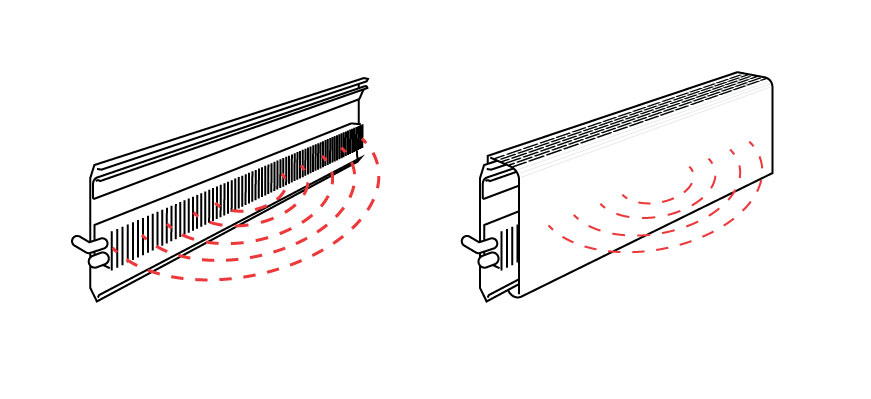What is the most efficient baseboard heater design ?
2019 May 30th
Heaters consume a lot of energy, so it is understandable that people would want to get the most efficient heater cover possible, so that none of that energy goes to waste.
In the video: veil's Atlas Baseboard Heater Cover, video taken with Flir heat camera.
To be able to figure out what makes the best baseboard heater cover, you will have to have at least a rudimentary understanding of how baseboard heaters work.
There are several kinds of baseboard heaters. The most common two are electric and hydronic baseboard heaters.
An electric heater usually has a separate power supply for each unit and it uses electrical current and resistance to generate heat through the heating element. They can reach high temperature pretty fast, although sometimes they can present a fire hazard, especially if the cover used has openings where small objects or particles can fall through to the heating element.
A hydronic heater on the other hand may take a bit longer reach its maximum temperature, however, due to the way they are designed, they rarely present any fire hazards, although they might still be a burn hazard especially for small children.
A hydronic heater can have a separate controller on each unit, although usually the heaters in one house or building would share one heating source, as in the animation below.

Whether your baseboard heater is hydroponic or electric, thanks to new innovations you do not have to settle with the default covers they come with that are probably not providing maximum efficiency, safety or style. In this article, we are going to focus on efficiency.
Heaters generate heat through two different mediums or routs. The first one, through which you get almost 95% of the heat, is convection. That is, when the heat transfers through the air. It is simple- the heating element inside heats the air around it, and according to the laws of physics and thermodynamics, the heated air rises up, making space for cooler air to be heated in turn, and the cycle continues. According to this, the best heater cover should always have its main openings at the top and the bottom: the bottom is where the cool air enters, and the top is where the hot air exists. Other openings on the covers can exist, however, they are usually there for aesthetics and do not affect the movement of heated air.

The second way heats gets transferred, and consists about 5% of all the heat transmitted from the heater through the heater cover, is radiance. Most baseboard heater cover manufacturers tend to ignore this rout as its effect is hardly noticeable by people. However, if you are looking for the most efficiency, then you have to keep it in mind.
Radiance is a property of any physical material, and it refers to the way it conducts heat. Materials differ in their nature, and each is assigned a Thermal Conductivity rate. Thermal Conductivity is the ability of any metal to conduct heat and is measured with the unit watts per meter kelvin (W/m K).

Aluminum is the metal with the highest Thermal Conductivity at 236 (W/m K). It is followed by Beryllium (218 W/m K), and the list goes on until we get to steel ( 59 W/m K). 1
Hence, a baseboard heater that is made of aluminum would be 4 times more efficient thank a steel one one it comes to catching every last bit of heat.
The takeaway from this article is, for maximum baseboard heater efficiency, make sure to pick a cover that is:
1. Has its main opening on top and has sufficient airflow from the bottom. Opening anywhere else do not actually affect convention or heat transmission through air.
2. Preferably is made of a material with a high Thermal Conductivity, such as aluminum.
1 https://www.engineeringtoolbox.com/thermal-conductivity-metals-d_858.html
